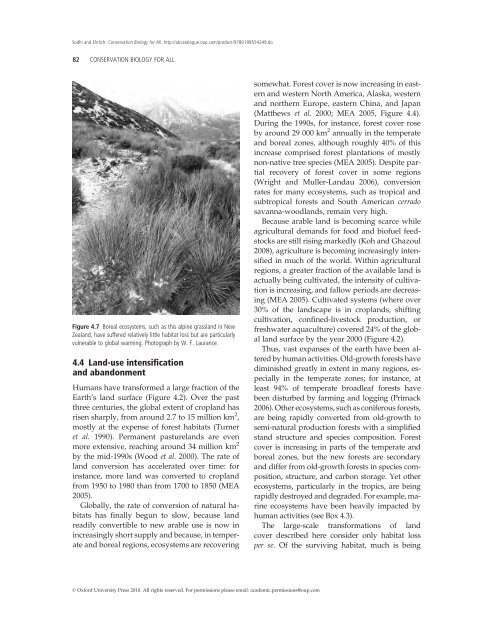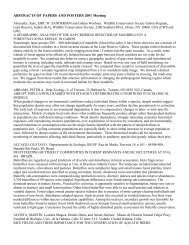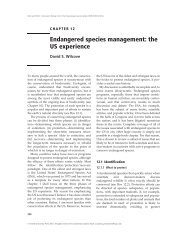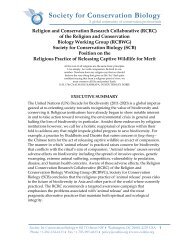Habitat Destruction: Death by a Thousand Cuts - Society for ...
Habitat Destruction: Death by a Thousand Cuts - Society for ...
Habitat Destruction: Death by a Thousand Cuts - Society for ...
- No tags were found...
Create successful ePaper yourself
Turn your PDF publications into a flip-book with our unique Google optimized e-Paper software.
Sodhi and Ehrlich: Conservation Biology <strong>for</strong> All. http://ukcatalogue.oup.com/product/9780199554249.do<br />
82 CONSERVATION BIOLOGY FOR ALL<br />
Figure 4.7 Boreal ecosystems, such as this alpine grassland in New<br />
Zealand, have suffered relatively little habitat loss but are particularly<br />
vulnerable to global warming. Photograph <strong>by</strong> W. F. Laurance.<br />
4.4 Land-use intensification<br />
and abandonment<br />
Humans have trans<strong>for</strong>med a large fraction of the<br />
Earth’s land surface (Figure 4.2). Over the past<br />
three centuries, the global extent of cropland has<br />
risen sharply, from around 2.7 to 15 million km 2 ,<br />
mostly at the expense of <strong>for</strong>est habitats (Turner<br />
et al. 1990). Permanent pasturelands are even<br />
more extensive, reaching around 34 million km 2<br />
<strong>by</strong> the mid-1990s (Wood et al. 2000). The rate of<br />
land conversion has accelerated over time: <strong>for</strong><br />
instance, more land was converted to cropland<br />
from 1950 to 1980 than from 1700 to 1850 (MEA<br />
2005).<br />
Globally, the rate of conversion of natural habitats<br />
has finally begun to slow, because land<br />
readily convertible to new arable use is now in<br />
increasingly short supply and because, in temperate<br />
and boreal regions, ecosystems are recovering<br />
somewhat. Forest cover is now increasing in eastern<br />
and western North America, Alaska, western<br />
and northern Europe, eastern China, and Japan<br />
(Matthews et al. 2000; MEA 2005, Figure 4.4).<br />
During the 1990s, <strong>for</strong> instance, <strong>for</strong>est cover rose<br />
<strong>by</strong> around 29 000 km 2 annually in the temperate<br />
and boreal zones, although roughly 40% of this<br />
increase comprised <strong>for</strong>est plantations of mostly<br />
non-native tree species (MEA 2005). Despite partial<br />
recovery of <strong>for</strong>est cover in some regions<br />
(Wright and Muller-Landau 2006), conversion<br />
rates <strong>for</strong> many ecosystems, such as tropical and<br />
subtropical <strong>for</strong>ests and South American cerrado<br />
savanna-woodlands, remain very high.<br />
Because arable land is becoming scarce while<br />
agricultural demands <strong>for</strong> food and biofuel feedstocks<br />
are still rising markedly (Koh and Ghazoul<br />
2008), agriculture is becoming increasingly intensified<br />
in much of the world. Within agricultural<br />
regions, a greater fraction of the available land is<br />
actually being cultivated, the intensity of cultivation<br />
is increasing, and fallow periods are decreasing<br />
(MEA 2005). Cultivated systems (where over<br />
30% of the landscape is in croplands, shifting<br />
cultivation, confined-livestock production, or<br />
freshwater aquaculture) covered 24% of the global<br />
land surface <strong>by</strong> the year 2000 (Figure 4.2).<br />
Thus, vast expanses of the earth have been altered<br />
<strong>by</strong> human activities. Old-growth <strong>for</strong>ests have<br />
diminished greatly in extent in many regions, especially<br />
in the temperate zones; <strong>for</strong> instance, at<br />
least 94% of temperate broadleaf <strong>for</strong>ests have<br />
been disturbed <strong>by</strong> farming and logging (Primack<br />
2006). Other ecosystems, such as coniferous <strong>for</strong>ests,<br />
are being rapidly converted from old-growth to<br />
semi-natural production <strong>for</strong>ests with a simplified<br />
stand structure and species composition. Forest<br />
cover is increasing in parts of the temperate and<br />
boreal zones, but the new <strong>for</strong>ests are secondary<br />
and differ from old-growth <strong>for</strong>ests in species composition,<br />
structure, and carbon storage. Yet other<br />
ecosystems, particularly in the tropics, are being<br />
rapidly destroyed and degraded. For example, marine<br />
ecosystems have been heavily impacted <strong>by</strong><br />
human activities (see Box 4.3).<br />
The large-scale trans<strong>for</strong>mations of land<br />
cover described here consider only habitat loss<br />
per se. Ofthesurvivinghabitat,muchisbeing<br />
© Ox<strong>for</strong>d University Press 2010. All rights reserved. For permissions please email: academic.permissions@oup.com






